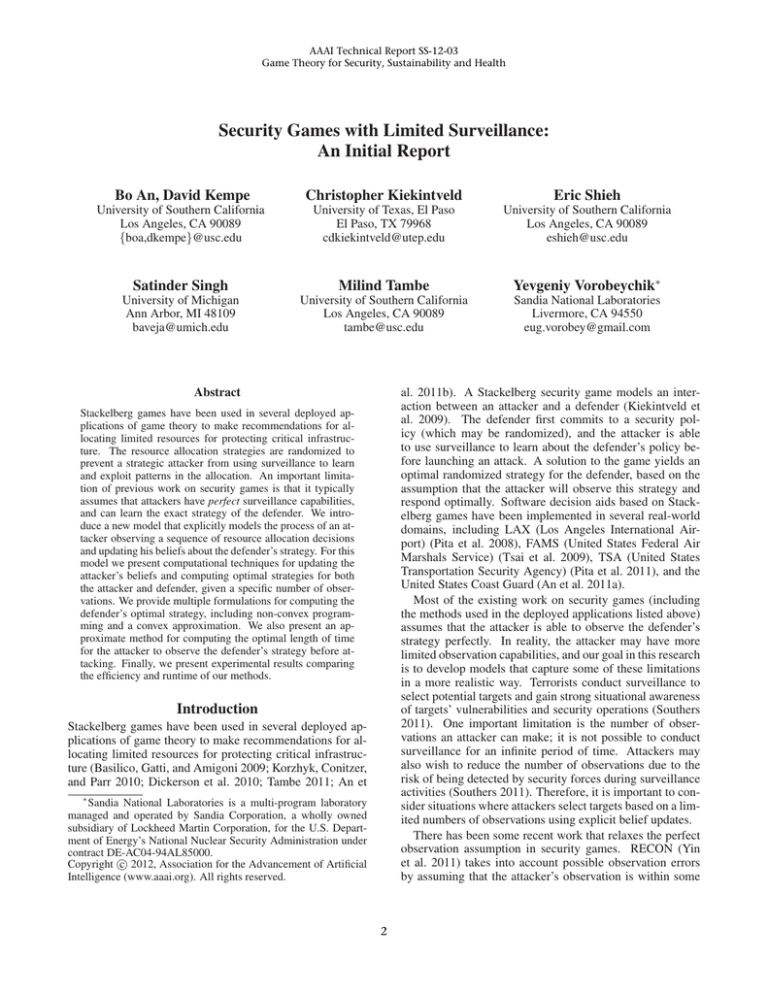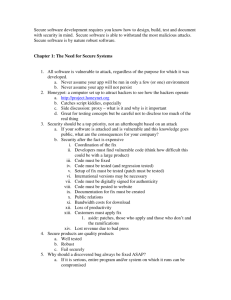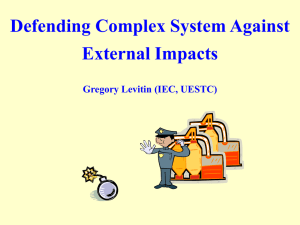Security Games with Limited Surveillance: An Initial Report Bo An, David Kempe
advertisement

AAAI Technical Report SS-12-03
Game Theory for Security, Sustainability and Health
Security Games with Limited Surveillance:
An Initial Report
Bo An, David Kempe
Christopher Kiekintveld
Eric Shieh
University of Southern California
Los Angeles, CA 90089
{boa,dkempe}@usc.edu
University of Texas, El Paso
El Paso, TX 79968
cdkiekintveld@utep.edu
University of Southern California
Los Angeles, CA 90089
eshieh@usc.edu
Satinder Singh
Milind Tambe
Yevgeniy Vorobeychik∗
University of Michigan
Ann Arbor, MI 48109
baveja@umich.edu
University of Southern California
Los Angeles, CA 90089
tambe@usc.edu
Sandia National Laboratories
Livermore, CA 94550
eug.vorobey@gmail.com
Abstract
al. 2011b). A Stackelberg security game models an interaction between an attacker and a defender (Kiekintveld et
al. 2009). The defender first commits to a security policy (which may be randomized), and the attacker is able
to use surveillance to learn about the defender’s policy before launching an attack. A solution to the game yields an
optimal randomized strategy for the defender, based on the
assumption that the attacker will observe this strategy and
respond optimally. Software decision aids based on Stackelberg games have been implemented in several real-world
domains, including LAX (Los Angeles International Airport) (Pita et al. 2008), FAMS (United States Federal Air
Marshals Service) (Tsai et al. 2009), TSA (United States
Transportation Security Agency) (Pita et al. 2011), and the
United States Coast Guard (An et al. 2011a).
Most of the existing work on security games (including
the methods used in the deployed applications listed above)
assumes that the attacker is able to observe the defender’s
strategy perfectly. In reality, the attacker may have more
limited observation capabilities, and our goal in this research
is to develop models that capture some of these limitations
in a more realistic way. Terrorists conduct surveillance to
select potential targets and gain strong situational awareness
of targets’ vulnerabilities and security operations (Southers
2011). One important limitation is the number of observations an attacker can make; it is not possible to conduct
surveillance for an infinite period of time. Attackers may
also wish to reduce the number of observations due to the
risk of being detected by security forces during surveillance
activities (Southers 2011). Therefore, it is important to consider situations where attackers select targets based on a limited numbers of observations using explicit belief updates.
There has been some recent work that relaxes the perfect
observation assumption in security games. RECON (Yin
et al. 2011) takes into account possible observation errors
by assuming that the attacker’s observation is within some
Stackelberg games have been used in several deployed applications of game theory to make recommendations for allocating limited resources for protecting critical infrastructure. The resource allocation strategies are randomized to
prevent a strategic attacker from using surveillance to learn
and exploit patterns in the allocation. An important limitation of previous work on security games is that it typically
assumes that attackers have perfect surveillance capabilities,
and can learn the exact strategy of the defender. We introduce a new model that explicitly models the process of an attacker observing a sequence of resource allocation decisions
and updating his beliefs about the defender’s strategy. For this
model we present computational techniques for updating the
attacker’s beliefs and computing optimal strategies for both
the attacker and defender, given a specific number of observations. We provide multiple formulations for computing the
defender’s optimal strategy, including non-convex programming and a convex approximation. We also present an approximate method for computing the optimal length of time
for the attacker to observe the defender’s strategy before attacking. Finally, we present experimental results comparing
the efficiency and runtime of our methods.
Introduction
Stackelberg games have been used in several deployed applications of game theory to make recommendations for allocating limited resources for protecting critical infrastructure (Basilico, Gatti, and Amigoni 2009; Korzhyk, Conitzer,
and Parr 2010; Dickerson et al. 2010; Tambe 2011; An et
∗
Sandia National Laboratories is a multi-program laboratory
managed and operated by Sandia Corporation, a wholly owned
subsidiary of Lockheed Martin Corporation, for the U.S. Department of Energy’s National Nuclear Security Administration under
contract DE-AC04-94AL85000.
c 2012, Association for the Advancement of Artificial
Copyright Intelligence (www.aaai.org). All rights reserved.
2
distance from the defender’s real strategy, but does not address how these errors arise or explicitly model the process
of forming beliefs based on limited observations. The COBRA algorithm (Pita et al. 2010) focuses on human perception of probability distributions by applying support theory (Tversky and Koehler 1994) from psychology. Both RECON and COBRA require hand-tuned parameters to model
observations errors, which we avoid in this paper. Yin et.
al (2010) prove the equivalence of Stackelberg equilibria
and Nash equilibria for some classes of security games.
In general, however, Stackelberg and Nash equilibria may
differ in security games, and the optimal strategy in cases
with limited surveillance may be different than both. There
also has been some work on understanding the value of
commitment for the leader in general Stackelberg games
where observations are limited or costly (Bagwell 1995;
Morgan and Vardy 2007; van Damme and Hurkens 1997).
The important difference between previous work and the
methods we develop in this paper is that we consider a more
detailed model of how attackers conduct surveillance operations and update their beliefs about the defender’s strategy.
We make the following contributions to this line of work:
(1) We introduce a model of security games with strategic surveillance and formulate how the attacker updates his
belief given limited observations. (2) We provide multiple
formulations for computing the defender’s optimal strategy,
including non-convex programming and a convex approximation. (3) We provide an approximate approach for computing the optimal number of observations for the attacker.
(4) We present experimental results comparing the efficiency
and runtime of the methods we develop.
The payoffs for each player depend on which target is attacked and the probability that the target is covered by the
defender. Given a target tj , the defender receives payoff Rjd
if the adversary attacks tj and it is covered; otherwise, the
defender receives payoff Pjd . The attacker receives payoff
Pja in the former case and payoff Rja in the latter case. We
assume that Rjd > Pjd and Rja > Pja , so adding resources to
cover a target hurts the attacker and helps the defender. For
a strategy profile hc, ai, the expected utilities for both agents
are given by (notations are listed in Table 1):
X
Ud (c, a)=
aj Ud (c, tj ), where Ud (c, tj ) = cj Rjd +(1− cj )Pjd
tj ∈T
X
Ua (c, a)=
aj Ua (c, tj ), where Ua (c, tj ) = cj Pja +(1− cj )Rja
tj ∈T
In a Stackelberg model, the defender chooses a strategy first, and the attacker chooses a strategy after observing the defender’s strategy. The standard solution concept for Stackelberg games is Strong Stackelberg Equilibrium (SSE) (Breton, Alg, and Haurie 1988; Leitmann 1978;
von Stengel and Zamir 2004). An SSE requires that the attacker will choose his best target(s) in response to the defender’s strategy, with ties broken optimally for the defender
if there are multiple best responses for the attacker. Since
there always exists an optimal pure-strategy response for the
attacker, we restrict the attacker’s strategies to pure strategies without loss of generality in this case.
We now introduce a new model that moves away from the
Stackelberg model of perfect observation for security games.
We call this class of games as ‘security games with strategic
surveillance (SGSS)’. In our model, the attacker makes a
limited number of observations. The attacker may decide the
number of observations to make strategically, considering
the cost of conducting surveillance. The sequence of moves
in an SGSS is as follows.
Stackelberg Security Games
A Stackelberg security game has two players, a defender
who decides how to use m identical resources to protect a
set of targets T = {t1 , t2 , . . . , t|T | } (m < |T |), and an attacker who selects a single target to attack. The defender’s
pure strategies are all possible feasible assignments of the
security resources to targets, with at most m targets from T
protected by a single resource each. The defender’s mixed
strategies consist of all probability distributions over these
pure strategies. The attacker’s pure strategies coincide with
the set of targets that can be attacked (T ). In a Stackelberg
game we assume that the attacker is able to (perfectly) observe the defender’s mixed strategy before selecting a target
to attack.
Let A = {Ai } be a set of feasible resource assignments,
where Ai is the defender’s ith pure strategy. If Aij = 1,
target tj is covered by the defender in assignment Ai , and
Aij = 0 otherwise. We denote a mixed strategy for the
defender by x = hxi i where xi is the probability of choosing
Ai . In many cases, we can use a compact representation for
this mixed strategy (Kiekintveld et al. 2009). The strategy
is representedPusing a marginal coverage vector c = hcj i
where cj =
Ai ∈A xi Aij is the probability that target tj
is covered by some defender resource. The attacker’s mixed
strategy is a vector a = haj i where aj is the probability of
attacking target tj .
1. The attacker first decides how many observations to make
(denoted by τ ), considering the subsequent game and the
cost incurred while making observations.
2. Next, the defender chooses a strategy considering the attacker’s prior beliefs about the defender’s strategy and the
number of observations the attacker will make.
3. Finally, the attacker makes τ observations and selects the
optimal target based on his posterior belief about the defender’s strategy.
We assume that the attacker and the defender have common prior beliefs over the set of mixed strategies that the
defender may execute. In addition, we introduce a discount
factor to model the cost of surveillance. We also assume
that the defender does not know the exact times when the
attacker will observe the strategy being executed, and therefore cannot strategically change the strategy during times
when it could be observed. This is realistic if the defender
is operating in a steady state, and does not know when or
where surveillance operations could take place for planning
a specific attack.
3
Variable
m
T
A
Φ
x
c
a
α
τ
f 0 (x)
f τ (x|o)
ao
coj
Z
γ
Definition
Number of defender resources
Set of targets
Set of defender strategies
All ways of allocating m resources on T
Defender mixed strategy xi
Defender coverage cj
Attacker coverage aj
Parameter of attacker’s prior belief
Number of observations
PDF of attacker’s prior belief
PDF of attacker’s posterior belief given o
Attacker’s strategy when his observation is o
Attacker’s updated belief about tj ’s coverage given o
Huge positive constant
Attacker’s utility discount rate
practice, the attackers will make only a limited number of
observations of how the checkpoints are placed before they
launch an attack. For example, they might observe placements for 20 days, and then launch an attack a week later
after finalizing plans for the attack based on analysis of the
security strategy. A single observation in this domain might
involve the attacker driving around the different entrances to
the airport to determine which ones are covered by checkpoints at any particular time, so each observation gives information about the full strategy of the defender.2
For simplicity, we assume in this work that the attacker’s
beliefs can be represented as a Dirichlet distribution, which
is a conjugate prior for the multinomial distribution. Specif0
ically, the support
Pfor the prior distribution f (x) is the simplex S = {x : Ai ∈Φ xi = 1, xi ≥ 0, ∀Ai ∈ Φ}, where
Φ is the enumeration of all possible ways of allocating m
resources to cover the targets in T .3 We can consider more
general security settings in which there may exist scheduling
constraints on the assignment of resources, e.g., resources
have restrictions on which sets of targets they can cover (Jain
et al. 2010). In this case, it follows that A ⊆ Φ. If we assume that the attacker has no knowledge of the defender’s
scheduling/resource constraints, the attacker will have priors and update beliefs on the set of pure strategies Φ.
The Dirichlet
for f 0 (x) is of the form
Q distribution
0
αi
f (x) = β Ai ∈Φ (xi ) where α = hαi i is a parameter
of the Dirichlet distribution and αi > 0. By
P solving the inR 0
( A ∈Φ αi +|Φ|−1)!
iQ
tegral β S f (x)dx = 1, we have β =
.
αi !
Table 1: Notations used in this paper
In the rest of the paper we apply a backwards induction
approach to analyze SGSS. First we model how the attacker
updates his belief and chooses the best target to attack. Then
we formulate an optimization problem for the defender’s optimal strategy, given that the attacker will make a known
number of observations. Finally, we discuss how the attacker can make a decision on how many observations to
make.
Updating Attacker Beliefs
In an SGSS, the attacker updates his beliefs about the defender’s strategy given his prior and τ observations, labeled
O0 , . . . , Oτ −1 , where each observation corresponds to one
of the defender’s pure strategies. The individual observations are drawn independently from the distribution representing the defender’s mixed strategy. We can imagine the
belief update proceeding sequentially, with an updated belief
calculated after each observation. The attacker begins with a
prior belief over the defender’s mixed strategies, represented
by the probability density function f 0 (x) which represents
the probability that the defender’s mixed strategy is x. We
assume this prior is common knowledge. Given the first
observation O0 , the attacker applies Bayes’ rule to calculate the posterior distribution f 1 (x|O0 ) over the defender’s
mixed strategies x. The posterior distribution f 1 (x) is then
used as the prior belief distribution for observation O1 . After
making τ observations, the attacker attacks the target with
the highest expected valued with respect to the final posterior distribution f τ (x|O0 , . . . , Oτ −1 ).
Ai ∈Φ
The prior belief can then be represented as follows:
f 0 (x) =
(
P
αi + |Φ| − 1)! Y
Ai ∈Φ
Q
Ai ∈Φ
αi !
(xi )αi
Ai ∈Φ
The probability that the defender will choose pure strategy Ai given the attacker’s prior belief f 0 (x) is
f 0 (xi ) =
Z
S
αi + 1
Ai ∈Φ αi + |Φ|
xi f 0 (x)dx = P
The marginal coverage of target tj given prior belief
f 0 (x) is
P
p0 (j) =
X
Ai ∈Φ
Aij f 0 (xi ) =
Ai ∈Φ
P
Aij (αi + 1)
Ai ∈Φ
αi + |Φ|
perts (Southers 2011), and follows other Stackelberg models deployed in practice and justified elsewhere (Pita et al. 2009). One
important factor in this is the difficulty of generating and executing
complex conditional plans with limited resources.
2
An alternative model could be developed where the attacker
picks one (or a few) targets to observe, and will therefore learn
about only part of the full pure strategy in each observation. We
consider the simpler case in this work where there is no decision
about which targets to observe, only how many observations to
make.
3
We assume that the attacker has prior knowledge about the
probability distribution f 0 (x) over the defender’s pure strategies.
It is also possible that the attacker has prior belief on targets
T ’s marginal coverage (say f 0 (c)). In that case, we can convert f 0 (c) to f 0 (x) by solving a set of linear functions cj =
P
Ai ∈Φ xi Aij , ∀tj ∈ T .
Example 1. We use the LAX airport as an example, based
on the ARMOR application. The police at LAX place m
checkpoints on the entrance roads to LAX following a mixed
strategy computed using the ARMOR system (Assistant for
Randomized Monitoring over Routes) (Pita et al. 2008). Attackers may engage in surveillance prior to an attack.1 In
1
The model in this paper assumes a surveillance phase prior to
any actual execution of an attack. In particular, we assume that
executing an attack is sufficiently complex that it is prohibitively
difficult to observe the pure strategy of the defender and immediately launch an attack against this pure strategy. This assumption is based on real-world cases and feedback from security ex-
4
his observation o. Therefore, we can compute offline the attacker’s optimal strategy ao for each observation o by solving the following linear program (LP):
P1:
1
If αi = αk for every i, k, f 0 (xi ) = |Φ|
for any strategy
Ai ∈ Φ. That is, (from the attacker’s perspective) the defender chooses each strategy with the same probability. The
probability of strategy Ai will increase with the increase of
αi .
Next we discuss how the attacker updates his belief given
his prior belief and the sequence of observations O =
{O0 , . . . , Oτ −1 } where Ok ∈ Φ. Let oi (O) (or oi for short)
be thePnumber of times each pure strategy Ai is executed,
with Ai ∈Φ oi = τ . If the defender’s mixed strategy is
x, the probability thatQthe attacker will observe o = hoi i is
f (o|x) = Q τ ! oi ! Ai ∈Φ (xi )oi . After the first observa0
Ai ∈Φ
1
max
d
o
o
aj
∈ {0, 1}
X o
aj = 1
(1)
∀tj ∈ T
(2)
(3)
t∈T
o
o
d
d
d
o
d − cj (Rj − Pj ) − Pj ≤ (1 − aj )Z
P
A ∈Φ Aij (αi + oi + 1)
o
cj =
Pi
A ∈Φ αi + |Φ| + τ
∀tj ∈ T
(4)
∀tj ∈ T
(5)
∀tj ∈ T
(6)
i
o
o
a
a
a
o
0 ≤ k − cj (Pj − Rj ) − Rj ≤ (1 − aj )Z
0
tion O = Ai , the attacker’s posterior distribution f (x|O )
can be computed by applying Bayes’ rule as follows:
The formulation P1 is similar to the MILP formulations
for security games presented in (Kiekintveld et al. 2009).
Equation (1) is the objective function which maximizes the
defender’s expected payoff from the attacker’s perspective.
As in a strong Stackelberg equilibrium, we still assume that
the attacker breaks ties in favor of the defender. Equations
(2) and (3) force the attacker vector to assign a single target
probability 1 for each observation o. Equation (4) defines
the defender’s payoff from the attacker’s perspective. Equation (6) defines the optimal response for attacker. Equation
(5) defines the attacker’s updated belief about the coverage
of each target given the observation o. ao represents the
attacker’s strategy when his observation is o. Z is a huge
positive constant. coj is the attacker’s updated belief about
the coverage of target tj if his observation is o. k o is the
attacker’s expected utility (from the attacker’s perspective)
when his observation is o.
P
( Ak ∈Φ αk + |Φ|)! Y
xi f (x)
Q
f 1 (x|O0 ) = R
=
(xk )αi xi
0 (x)dx
α
!(α
+
1)
x
f
i
k
i
Ak ∈Φ
S
A ∈Φ
0
k
After applying Bayes’ rule for all τ observations, we can
calculate the posterior distribution as:
P
( Ai ∈Φ αi + |Φ| + τ − 1)! Y
Q
f (x|o) =
(xi )αi +oi
Ai ∈Φ (αi + oi )!
A ∈Φ
τ
i
The marginal coverage of target tj given the posterior belief f τ (x) is
P
τ
p (j) =
X
τ
Aij f (xi ) =
Ai ∈Φ
P
Ai ∈Φ
Aij (αi + oi + 1)
Ai ∈Φ
αi + |Φ| + τ
In the rest of this section, we provide three mathematical programming formulations for computing the defender’s
optimal strategy x∗ when the number τ of observations is
known. Throughout, we assume that ao is known for each
potential observation o.
After calculating these belief updates for all of the observations, the attacker chooses the best target to attack based
on the final posterior belief f τ (x|o). The defender’s real
strategy x can affect the probability of the attacker’s observations and therefore affect the attacker’s choice of target.
Computing the Defender’s Optimal Strategy
In this section we consider the problem of computing the
defender’s optimal strategy x given (1) the attacker’s prior
belief f 0 (x) represented as a Dirichlet distribution with parameter α = hαi i, and (2) the fact that the attacker will
make a known and fixed number of observations (τ ) before
launching his attack.
Non-convex Optimization Formulation
The formulation P2 provides a straightforward approach for
computing the defender’s optimal strategy. Equation (7) is
the objective function
which maximizes the defender’s exP
pected payoff o∈Oτ f (o|x)do where do is the defender’s
utility when the attacker’s observation is o. Equations (8)
and (9) restrict the defender’s strategy space x. Equation
(10) computes each target’s marginal coverage given the defender’s strategy x. Equation (11) defines the defender’s expected payoff do when the attacker’s observation is o. The
constraint places an upper bound cj (Rjd − Pjd ) + Pjd on the
defender’s expected utility do when tj is attacked.
Attacker’s Optimal Strategy
We first discuss the problem of calculating the optimal attacker strategy in response to a defender strategy. Let Oτ
be the space of possible observations when the attacker
makes τ observations,
represented as Oτ = {o : oi ∈
P
{0, . . . , τ }, Ai ∈A oi = τ }. The space Oτ is finite and
independent of the defender’s strategy x.
One feature of SGSS is that the attacker’s decision about
which target to attack is determined by his prior belief and
5
P2:
τ!
Q
o∈Oτ
Ai
Y
∈A oi !
oi
o
(7)
xi ∈ [0, 1] ∀Ai ∈ A
X
xi = 1
(8)
(xi )
d
Ai ∈A
Time(sec)
X
max
(9)
Ai ∈A
cj =
X
xi Aij
∀tj ∈ T
(10)
∀tj , o ∈ T × Oτ
(11)
Ai ∈A
o
d
d
d
o
Figure 2: Runtime with different observation lengths (|T | =
5)
The objective function (7) in formulation P2 is not convex,
and no existing solver can guarantee finding the optimal solution. One approach in this case is to fall back to approximation. In this case, we can approximate the original problem by taking the log inside the summation
for the objective
P
function, changing equation (7) to o∈Oτ log Q τ ! oi ! +
Ai ∈A
P
o
o
Ai ∈A oi log(xi )+log d . However, the value of d could
be negative, so we cannot safely apply the log operator. This
issue can be resolved by adding a large value to each entry
in the payoffP
matrix so do will alwaysPbe positive. Since
the equation o∈Oτ log Q τ ! oi ! + Ai ∈A oi log(xi ) +
Ai ∈A
log do is concave, we can convert this to a convex minimization problem as follows:
P3:
− log Q
τ!
Ai
o∈Oτ
∈A oi !
convex
Number of Observations
Convex Approximation
X
non convex
5 6 7 8 9 10 11 12 13 14 15 16 17 18 19 20
d − cj (Rj − Pj ) − Pj ≤ (1 − aj )Z
min
5
4.5
4
3.5
3
2.5
2
1.5
1
0.5
0
−
X
o
(12)
(8) − (11)
(13)
oi log(xi ) − log d
120
Objective Value
100
80
60
non convex
40
convex
20
0
5
6
7
8
9 10 11 12 13 14 15 16 17 18
Number of Targets
Figure 3: Utility with different number of targets (τ = 5)
Ai ∈A
terms of the number of targets or observations), and the yaxis is runtime in seconds. Initial results show that the convex optimization formulation P3 is faster compared to formulation P2 and the advantage increases with the increase
of the scale of the game.
We have conducted initial experiments to evaluate the
above two formulations P2 and P3. In all the experiments,
there is one defender resource, a varying numbers of targets, and randomly-generated payoffs satisfying the constraint that rewards are higher than penalties. Rjd and Rja
are drawn uniformly from the range [100, 200]. Pjd and Pja
are drawn uniformly from the range [0, 100]. The results
were averaged over 250 trials.
Figure 3 and 4 compare the expected defender utilities for
formulations P2 and P3. The x-axis is the size of the game
(in terms of the number of targets or observations), and the
y-axis is runtime in seconds. We can find that the approximate approach (P3) achieved lower expected defender utility with different number of targets and observations.
25
Time(sec)
20
15
The Optimal Number of Observations
non convex
10
convex
5
0
5
6
7
8
This section discusses how the attacker decides the number of observations to make in consideration of surveillance
cost. We model surveillance cost by introducing a discount
factor λ ∈ (0, 1) for the attacker. We can then formulate the
attacker’s optimization problem with the discount factor as
a bilevel optimization problem P4 by extending the formulation P2:
9 10 11 12 13 14 15 16 17 18
Number of Targets
Figure 1: Runtime with different number of targets(τ = 5)
Figures 1 and 2 compare the runtime performance of formulations P2 and P3. The x-axis is the size of the game (in
6
120
non-convex programming and convex approximation. (3)
We provide an approximate approach for computing the attacker’s optimal surveillance length. (4) We present initial
experimental results comparing the efficiency and runtime
of our algorithms.
Our future work will focus on designing more efficient
algorithms for computing the optimal strategy. Since solving
bilevel optimization problems is very difficult, we will also
look at some heuristic algorithm such as penalty function
methods and trust-region methods. We also plan to conduct
more extensive experiments to explore the implications of
limited observation on both the strategies and outcomes in
security games.
Objective Value
100
80
60
non convex
40
convex
20
0
5 6 7 8 9 10 11 12 13 14 15 16 17 18 19 20
Number of Observations
Figure 4: Utility with different observation lengths (|T | = 5)
P4:
Acknowledgments
τ
max λ
τ!
X
Q
τ
o∈Oτ
x = argmax
Y
Ai ∈A
oi ! A
τ!
X
Q
o∈Oτ
Y
Ai ∈A
oi o
k
(14)
τ ∈N
(15)
(xi )
This research is supported by MURI grant W911NF-11-10332 and ONR grant N00014-08-1-0733.
i ∈A
oi ! A
oi
(xi )
o
d
References
(16)
An, B.; Pita, J.; Shieh, E.; Tambe, M.; Kiekintveld, C.; and
Marecki, J. 2011a. Guards and protect: Next generation
applications of security games. SIGECOM 10:31–34.
An, B.; Tambe, M.; Ordonez, F.; Shieh, E.; and Kiekintveld,
C. 2011b. Refinement of strong stackelberg equilibria in
security games. In Proc. of the 25th Conference on Artificial
Intelligence, 587–593.
Bagwell, K. 1995. Commitment and observability in games.
Games and Economic Behavior 8:271–280.
Basilico, N.; Gatti, N.; and Amigoni, F. 2009. Leaderfollower strategies for robotic patrolling in environments
with arbitrary topologies. In Proc. of The 8th International
Conference on Autonomous Agents and Multiagent Systems
(AAMAS), 500–503.
Breton, M.; Alg, A.; and Haurie, A. 1988. Sequential stackelberg equilibria in two-person games. Optimization Theory
and Applications 59(1):71–97.
Dickerson, J. P.; Simari, G. I.; Subrahmanian, V. S.; and
Kraus, S. 2010. A graph-theoretic approach to protect static
and moving targets from adversaries. In Proc. of The 9th
International Conference on Autonomous Agents and Multiagent Systems (AAMAS), 299–306.
Jain, M.; Kardes, E.; Kiekintveld, C.; Ordonez, F.; and
Tambe, M. 2010. Security games with arbitrary schedules:
A branch and price approach. In Proc. of The 24th AAAI
Conference on Artificial Intelligence, 792–797.
Kiekintveld, C.; Jain, M.; Tsai, J.; Pita, J.; Tambe, M.; and
Ordonez, F. 2009. Computing optimal randomized resource
allocations for massive security games. In Proc. of The 8th
International Conference on Autonomous Agents and Multiagent Systems (AAMAS), 689–696.
Korzhyk, D.; Conitzer, V.; and Parr, R. 2010. Complexity of computing optimal stackelberg strategies in security
resource allocation games. In Proc. of The 24th AAAI Conference on Artificial Intelligence, 805–810.
Leitmann, G. 1978. On generalized stackelberg strategies.
Optimization Theory and Applications 26(4):637–643.
i ∈A
xi ∈ [0, 1] ∀Ai ∈ A
X
xi = 1
(17)
(18)
Ai ∈A
cj =
X
xi Aij
∀tj ∈ T
(19)
∀tj , o ∈ T ×Oτ
(20)
∀tj , o ∈ T ×Oτ
(21)
Ai ∈A
o
d
o
o
a
cj (Pj
d
d
o
d − cj (Rj − Pj ) − Pj ≤ (1 − aj )Z
0≤k −
−
a
Rj )
−
a
Rj
≤ (1 −
o
aj )Z
In formulation P4, Equation (14) is the objective
function
P which maximizes the attacker’s expected payoff
λτ o∈Oτ f (o|x)k o when the attacker makes τ observations, and the defender takes strategy x. Equation (15) restricts the possible number of observations the attacker can
make. Equations (16)-(21) maximize the defender’s expected utility when τ is known. k o is the attacker’s utility
when 1) the attacker makes τ observations and 2) the defender takes strategy x.
Bilevel optimization problems are intrinsically hard, and
P4 is even more difficult to solve since both the upper-level
problem and the second-level problem are not convex. One
approach is to try different values of τ and solve the defender’s optimization problems using the methods described
previously. Intuitively, due to the existence of discount factor λ, the attacker’s utility will decrease as τ increases for
sufficiently large values of τ . Therefore, we may be able to
use some form of intelligent search to find the optimal value
of τ .
Conclusion
This paper explicitly models the attacker’s belief update
and strategic surveillance decisions in security games, and
presents efficient solution techniques to compute agents’ optimal strategies. Our primary contributions are as follows:
(1) We model the security games with strategic surveillance
and formulate how the attacker updates his belief given limited observations. (2) We provide multiple formulations
for computing the defender’s optimal strategies, including
7
Morgan, J., and Vardy, F. 2007. The value of commitment in
contests and tournaments when observation is costly. Games
and Economic Behavior 60(2):326–338.
Pita, J.; Jain, M.; Western, C.; Portway, C.; Tambe, M.; Ordonez, F.; Kraus, S.; and Parachuri, P. 2008. Deployed
ARMOR protection: The application of a game-theoretic
model for security at the Los Angeles International Airport.
In Proc. of The 7th International Conference on Autonomous
Agents and Multiagent Systems (AAMAS), 125–132.
Pita, J.; Jain, M.; Ordóñez, F.; Tambe, M.; Kraus, S.; and
Magori-Cohen, R. 2009. Effective solutions for real-world
stackelberg games: When agents must deal with human uncertainties. In Proc. of The 8th International Conference on
Autonomous Agents and Multiagent Systems (AAMAS).
Pita, J.; Jain, M.; Tambe, M.; Ordóñez, F.; and Kraus, S.
2010. Robust solutions to stackelberg games: Addressing
bounded rationality and limited observations in human cognition. Artificial Intelligence 174(15):1142–1171.
Pita, J.; Tambe, M.; Kiekintveld, C.; Cullen, S.; and Steigerwald, E. 2011. Guards - game theoretic security allocation on a national scale. In Proc. of The 10th International
Conference on Autonomous Agents and Multiagent Systems
(AAMAS).
Southers, E. 2011. LAX - terror target: the history, the
reason, the countermeasure. Cambridge University Press.
chapter Security and Game Theory: Algorithms, Deployed
Systems, Lessons Learned, 27–50.
Tambe, M. 2011. Security and Game Theory: Algorithms,
Deployed Systems, Lessons Learned. Cambridge University
Press.
Tsai, J.; Rathi, S.; Kiekintveld, C.; Ordonez, F.; and Tambe,
M. 2009. IRIS: a tool for strategic security allocation in
transportation networks. In Proc. of The 8th International
Conference on Autonomous Agents and Multiagent Systems
(AAMAS), 37–44.
Tversky, A., and Koehler, D. J. 1994. Support thoery: A
nonextensional representation of subjective probability. Psychological Review 101:547–567.
van Damme, E., and Hurkens, S. 1997. Games with imperfectly observable commitment. Games and Economic Behavior 21(1-2):282–308.
von Stengel, B., and Zamir, S. 2004. Leadership with commitment to mixed strategies. Technical Report LSE-CDAM2004-01, CDAM Research Report.
Yin, Z.; Korzhyk, D.; Kiekintveld, C.; Conitzer, V.; ; and
Tambe, M. 2010. Stackelberg vs. nash in security games:
interchangeability, equivalence, and uniqueness. In Proc.
of The 9th International Conference on Autonomous Agents
and Multiagent Systems (AAMAS), 1139–1146.
Yin, Z.; Jain, M.; Tambe, M.; and Ordonez, F. 2011. Riskaverse strategies for security games with execution and observational uncertainty. In Proc. of The 25th AAAI Conference on Artificial Intelligence (AAAI), 758–763.
8






